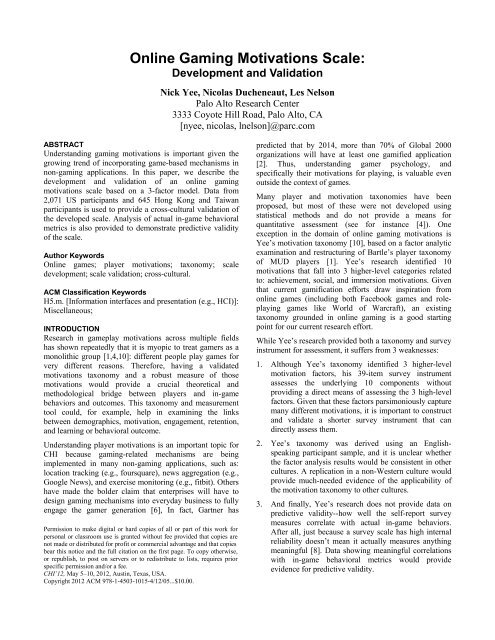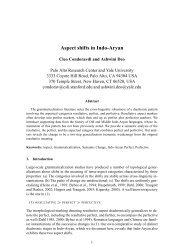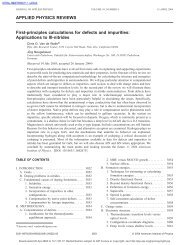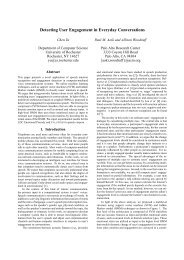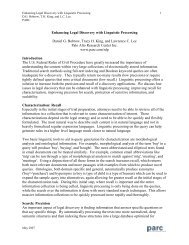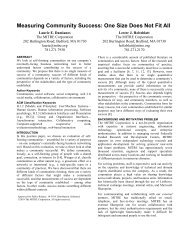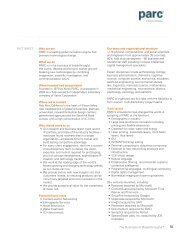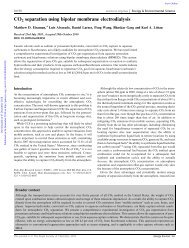Online Gaming Motivations Scale: - Nick Yee
Online Gaming Motivations Scale: - Nick Yee
Online Gaming Motivations Scale: - Nick Yee
Create successful ePaper yourself
Turn your PDF publications into a flip-book with our unique Google optimized e-Paper software.
<strong>Online</strong> <strong>Gaming</strong> <strong>Motivations</strong> <strong>Scale</strong>:<br />
Development and Validation<br />
<strong>Nick</strong> <strong>Yee</strong>, Nicolas Ducheneaut, Les Nelson<br />
Palo Alto Research Center<br />
3333 Coyote Hill Road, Palo Alto, CA<br />
[nyee, nicolas, lnelson]@parc.com<br />
ABSTRACT<br />
Understanding gaming motivations is important given the<br />
growing trend of incorporating game-based mechanisms in<br />
non-gaming applications. In this paper, we describe the<br />
development and validation of an online gaming<br />
motivations scale based on a 3-factor model. Data from<br />
2,071 US participants and 645 Hong Kong and Taiwan<br />
participants is used to provide a cross-cultural validation of<br />
the developed scale. Analysis of actual in-game behavioral<br />
metrics is also provided to demonstrate predictive validity<br />
of the scale.<br />
Author Keywords<br />
<strong>Online</strong> games; player motivations; taxonomy; scale<br />
development; scale validation; cross-cultural.<br />
ACM Classification Keywords<br />
H5.m. [Information interfaces and presentation (e.g., HCI)]:<br />
Miscellaneous;<br />
INTRODUCTION<br />
Research in gameplay motivations across multiple fields<br />
has shown repeatedly that it is myopic to treat gamers as a<br />
monolithic group [1,4,10]: different people play games for<br />
very different reasons. Therefore, having a validated<br />
motivations taxonomy and a robust measure of those<br />
motivations would provide a crucial theoretical and<br />
methodological bridge between players and in-game<br />
behaviors and outcomes. This taxonomy and measurement<br />
tool could, for example, help in examining the links<br />
between demographics, motivation, engagement, retention,<br />
and learning or behavioral outcome.<br />
Understanding player motivations is an important topic for<br />
CHI because gaming-related mechanisms are being<br />
implemented in many non-gaming applications, such as:<br />
location tracking (e.g., foursquare), news aggregation (e.g.,<br />
Google News), and exercise monitoring (e.g., fitbit). Others<br />
have made the bolder claim that enterprises will have to<br />
design gaming mechanisms into everyday business to fully<br />
engage the gamer generation [6], In fact, Gartner has<br />
Permission to make digital or hard copies of all or part of this work for<br />
personal or classroom use is granted without fee provided that copies are<br />
not made or distributed for profit or commercial advantage and that copies<br />
bear this notice and the full citation on the first page. To copy otherwise,<br />
or republish, to post on servers or to redistribute to lists, requires prior<br />
specific permission and/or a fee.<br />
CHI’12, May 5–10, 2012, Austin, Texas, USA.<br />
Copyright 2012 ACM 978-1-4503-1015-4/12/05...$10.00.<br />
predicted that by 2014, more than 70% of Global 2000<br />
organizations will have at least one gamified application<br />
[2]. Thus, understanding gamer psychology, and<br />
specifically their motivations for playing, is valuable even<br />
outside the context of games.<br />
Many player and motivation taxonomies have been<br />
proposed, but most of these were not developed using<br />
statistical methods and do not provide a means for<br />
quantitative assessment (see for instance [4]). One<br />
exception in the domain of online gaming motivations is<br />
<strong>Yee</strong>’s motivation taxonomy [10], based on a factor analytic<br />
examination and restructuring of Bartle’s player taxonomy<br />
of MUD players [1]. <strong>Yee</strong>’s research identified 10<br />
motivations that fall into 3 higher-level categories related<br />
to: achievement, social, and immersion motivations. Given<br />
that current gamification efforts draw inspiration from<br />
online games (including both Facebook games and roleplaying<br />
games like World of Warcraft), an existing<br />
taxonomy grounded in online gaming is a good starting<br />
point for our current research effort.<br />
While <strong>Yee</strong>’s research provided both a taxonomy and survey<br />
instrument for assessment, it suffers from 3 weaknesses:<br />
1. Although <strong>Yee</strong>’s taxonomy identified 3 higher-level<br />
motivation factors, his 39-item survey instrument<br />
assesses the underlying 10 components without<br />
providing a direct means of assessing the 3 high-level<br />
factors. Given that these factors parsimoniously capture<br />
many different motivations, it is important to construct<br />
and validate a shorter survey instrument that can<br />
directly assess them.<br />
2. <strong>Yee</strong>’s taxonomy was derived using an Englishspeaking<br />
participant sample, and it is unclear whether<br />
the factor analysis results would be consistent in other<br />
cultures. A replication in a non-Western culture would<br />
provide much-needed evidence of the applicability of<br />
the motivation taxonomy to other cultures.<br />
3. And finally, <strong>Yee</strong>’s research does not provide data on<br />
predictive validity--how well the self-report survey<br />
measures correlate with actual in-game behaviors.<br />
After all, just because a survey scale has high internal<br />
reliability doesn’t mean it actually measures anything<br />
meaningful [8]. Data showing meaningful correlations<br />
with in-game behavioral metrics would provide<br />
evidence for predictive validity.
The current study attempts to resolve these 3 weaknesses<br />
by: 1) constructing and validating a survey measure of the 3<br />
high-level motivation factors via factor analysis, 2)<br />
replicating the factor structure in a non-Western culture,<br />
and 3) examining the predictive validity of the scale in<br />
terms of correlations with in-game behavioral metrics.<br />
STUDY ONE - SCALE DEVELOPMENT<br />
We first describe how the revised scale was constructed and<br />
the initial validation of the scale using exploratory factor<br />
analysis.<br />
<strong>Scale</strong> Construction<br />
First, strong inventory items in each of the 10 components<br />
from <strong>Yee</strong>’s 39-item scale were selected via factor loading.<br />
Then, in several intermediate pilot surveys (each with N ><br />
300), we tested variants of these inventory items and<br />
iteratively selected items that had high factor loadings. In<br />
creating variants, we attempted to create shorter, more<br />
direct inventory items. For example, the item “How<br />
important is it to you that your character is as optimized as<br />
possible for their profession or role?” was revised to<br />
“Optimizing your character as much as possible”. We also<br />
avoided items that were semantically similar. Finally, we<br />
streamlined the response options. Thus, while the original<br />
inventory items varied in using “how much”, “how often”,<br />
“how interested”, and “how important” question stems, the<br />
revised items are all framed using “how important are these<br />
gameplay elements when you play online games”. Thus, the<br />
response options are identical for all inventory items--a 5-<br />
point Likert scale ranging from 1 (Not Important At All) to<br />
5 (Extremely Important). In the final iteration of this<br />
process, we selected 12 items (4 for each factor) as the final<br />
inventory set to be tested in this study (see Table 1).<br />
Participants<br />
To collect data for scale validation, we recruited World of<br />
Warcraft (WoW) players in the US to participate in an<br />
online survey version of the scale by posting<br />
announcements in high traffic websites and forums<br />
dedicated to WoW. Altogether, 2,071 WoW players<br />
participated in the survey. Of the participants, 1,358 were<br />
male, 709 were female, with an average age of 29.95 (SD =<br />
9.20).<br />
Exploratory Factor Analysis<br />
To examine the underlying factor structure of the revised<br />
scale, we conducted an exploratory factor analysis (EFA)--a<br />
statistical procedure that examines the covariances among a<br />
set of variables to identify latent factors.<br />
Kaiser's Meyer-Olkin measure of sampling adequacy was<br />
.78, while Bartlett's Test of Sphericity was significant at p <<br />
.001. These two measures indicate that the data set was<br />
appropriate for factor analysis.<br />
We conducted an EFA in SPSS 18 using principal factors<br />
analysis. Given that most psychometric factors are mildly<br />
correlated, we used an oblique rotation. Three factors<br />
emerged with eigenvalues greater than 1. Examination of<br />
the scree plot also suggested a solution with 3 factors.<br />
Together, these 3 factors accounted for 59.3% of the overall<br />
variance. In Table 1, we report the pattern matrix.<br />
Item Soc. Imm. Ach.<br />
Chatting with other players 0.73<br />
Being part of a guild 0.70<br />
Grouping with other players 0.67<br />
Keeping in touch with your friends 0.60 0.11<br />
Learning about stories and lore of the<br />
world<br />
0.78 0.12<br />
Feeling immersed in the world 0.73 0.11<br />
Exploring the world just for the sake of<br />
exploring it<br />
Creating a background story and history<br />
for your character<br />
0.60 -0.14<br />
0.54 -0.13<br />
Becoming powerful 0.73<br />
Acquiring rare items 0.13 0.68<br />
Optimizing your character as much as<br />
possible<br />
-0.12 0.67<br />
Competing with other players 0.55<br />
% of Variance 23.9% 21.4% 13.9%<br />
Cronbach's .77 .75 .74<br />
Table 1. Factor loadings. For ease of reference, we sort the items<br />
using their factor loadings with the primary loadings bolded, and<br />
exclude any factor loadings less than .10.<br />
The pattern matrix shows that the scale items loaded onto 3<br />
factors that correspond to Immersion, Social, and<br />
Achievement motivations respectively. The factor loadings<br />
are high; most are over .60. None of the cross-loadings are<br />
higher than .2. Finally, the scale items within each factor all<br />
have Cronbach 's above .70. Together, these findings<br />
suggest that the revised scale has a good factor structure<br />
and good internal reliability. In terms of inter-factor<br />
correlations, the Social factor was correlated with the<br />
Immersion and Achievement factors at .09 and .24<br />
respectively. The Immersion factor was correlated with the<br />
Achievement factor at -.21.<br />
Factor<br />
Achievement<br />
Social<br />
Immersion<br />
Gender Means<br />
(SD)<br />
Male = .14 (.83)<br />
Female = -.27 (.91)<br />
Male = -.05 (.88)<br />
Female = .09 (.90)<br />
Male = -.07 (.89)<br />
Female = .13 (.87)<br />
Table 2. Gender and age differences.<br />
Gender<br />
Differences<br />
t = 10.08<br />
p < .001<br />
t = -3.43<br />
p < .005<br />
t = -4.70<br />
p < .001<br />
Age<br />
Corr.<br />
r = -.27<br />
p < .001<br />
r = -.13<br />
p < .001<br />
r = -.01<br />
p = .64<br />
For completeness, we report the gender and age differences<br />
related to the motivation factors in Table 2. We note that<br />
these differences are consistent with those previously<br />
reported [10].
STUDY TWO - CROSS-CULTURAL VALIDATION<br />
To validate the scale cross-culturally, we recruited<br />
participants from Hong Kong (HK) and Taiwan (TW).<br />
These two non-Western cultures were selected because they<br />
share the same server pools (in Taiwan) and share a written<br />
language (traditional Chinese script).<br />
<strong>Scale</strong> Preparation<br />
To localize the scale, a bilingual translator first translated<br />
the scale into Chinese (traditional script). We then piloted<br />
the translated instrument with several WoW players in the<br />
two locations for idiomatic fluency and made several<br />
revisions. Finally, a different translator back-translated the<br />
scale into English to ensure the two English scales were<br />
comparable.<br />
Participants<br />
To collect data for the study, we recruited WoW players<br />
from HK and TW to participate in the online survey version<br />
of the scale by posting announcements in high traffic<br />
websites and forums dedicated to WoW. Altogether, 645<br />
players participated in the study--406 from TW, 239 from<br />
HK. 514 participants were male, 128 were female. The<br />
average age was 23.59 (SD = 5.16).<br />
Confirmatory Factor Analysis<br />
To verify that the 3-factor structure replicates in a non-<br />
Western culture, we conducted a confirmatory factor<br />
analysis (CFA)--a statistical procedure that compares the fit<br />
of the data with a factor model specified by the researcher,<br />
or in essence, the opposite of the EFA procedure.<br />
We conducted a CFA with Amos 18. In the specified CFA<br />
model, the three motivation factors were included as latent<br />
variables, each hypothesized to have a direct effect on the 4<br />
corresponding measured scale items. Unique measurement<br />
errors were hypothesized to have a direct effect on each<br />
measured scale item. Finally, the 3 latent factors were<br />
hypothesized to co-vary with each other.<br />
Maximum likelihood estimation was used for the analysis.<br />
The chi-square statistic of the model was significant ( 2<br />
[51] = 140.88, p < .001) as is expected from the large<br />
sample size. In these scenarios, goodness of fit indices<br />
provide a more meaningful assessment. We report here the<br />
common set of indices recommended: CFI = .95, SRMR =<br />
.04, and RMSEA = .05. All these values fall within the<br />
range of current recommendations for good model fit [3].<br />
Thus, data from HK and TW were consistent with the 3-<br />
factor structure identified in the US data. More importantly,<br />
this implies that the factor structure of motivations we have<br />
identified is not simply an artifact of Western culture, and<br />
has some level of cross-cultural applicability.<br />
STUDY THREE - PREDICTIVE VALIDITY<br />
To examine predictive validity of the scale, we collected<br />
behavioral metrics within WoW and examined the<br />
correlations between the self-report and behavioral data.<br />
Behavioral Metrics in WoW<br />
The context of WoW and the availability of in-game<br />
metrics via the Armory have been described in the CHI<br />
literature [9]. Of particular relevance to our research goal is<br />
the existence of hundreds of in-game goals known as<br />
achievements. For example, there are achievements for<br />
exploring every zone within a continent, and achievements<br />
for killing a dungeon boss within a short amount of time.<br />
More importantly, these achievements are grouped into 6<br />
categories and an aggregate achievement score is provided<br />
for each. These behavioral categories are automatically<br />
calculated and compiled by the game and require no<br />
additional coding on our part. These achievement categories<br />
map on to very different aspects of gameplay within WoW:<br />
<br />
<br />
<br />
<br />
<br />
<br />
Quests: Individual, easy, goal-based missions.<br />
Exploration: Systematic geographical exploration.<br />
PvP: Competitive, player-vs-player activity.<br />
Dungeons/Raids: Team-based collaboration with large<br />
rewards.<br />
Professions: Non-combat crafting skills.<br />
World Events: Thematic, seasonal, story-based events.<br />
Our first hypothesis is that each of the motivation factors<br />
has a significant impact across this set of in-game<br />
behavioral categories.<br />
To examine whether the relationships between the<br />
motivation factors and in-game behaviors are aligned with<br />
theory, we leveraged the behavioral expectations of the<br />
motivation factors from <strong>Yee</strong>'s original work [10]. We<br />
hypothesized that the Achievement factor would correlate<br />
positively with Dungeons/Raids and PvP (related to <strong>Yee</strong>'s<br />
Advancement and Competition components respectively).<br />
We hypothesized that the Social factor would correlate<br />
positively with Dungeons/Raids, suggested by <strong>Yee</strong>'s<br />
Teamwork component. And we hypothesized that the<br />
Immersion factor would correlate positively with<br />
Exploration, as suggested by <strong>Yee</strong>'s Discovery component.<br />
Data Collection<br />
From the data sets already collected, we randomly sampled<br />
500 participants from the US region, as well as 500<br />
participants from the HK and TW region for behavioral<br />
data collection. In the online survey, participants were<br />
asked to list their active characters. On average, each<br />
participant had 2.79 active characters (SD = 1.51). We used<br />
an XML scraper to collect data from the Armory for each<br />
character over a 6-month period and used the most recent<br />
character snapshots for the following analysis.<br />
To generate a player-level metric across characters, we<br />
calculated the score ratio for each achievement category<br />
(i.e., = category achievement score/total achievement score)<br />
across all of a player's characters. This allowed us to avoid<br />
confounding achievement scores with character levels.
Results<br />
We calculated the factor score for each motivation factor<br />
and conducted a multivariate regression using these factor<br />
scores to predict the in-game achievement category ratios,<br />
controlling for gender and age. The multivariate tests were<br />
significant for the Achievement (F = 19.95, p < .001),<br />
Social (F = 11.61, p < .001), and Immersion (F = 3.38, p <<br />
.01) factors. Thus, it is clear that the self-report data has a<br />
significant relationship with the set of in-game behavioral<br />
metrics. The individual regression coefficients are shown in<br />
Table 2. Our hypothesized correlations are all supported by<br />
the data. In addition, we note that the Achievement factor is<br />
strongly negatively correlated with Professions,<br />
Exploration, and Quests. In hindsight, it makes sense that<br />
activities that do not lead directly to functional rewards are<br />
not appealing to Achievement-oriented players. The same is<br />
true of the negative correlation between Quests and the<br />
Social factor. Given that quests are now designed to be<br />
completed alone, it is not surprising in hindsight that<br />
Social-oriented players find quests less appealing.<br />
Category ACH SOC IMM Adj R 2 p<br />
Quests -.21 -.16 .10 .13 < .001<br />
Exploration -.21 -.09 .09 .17 < .001<br />
PvP .14 -.05 -.07 .18 < .001<br />
Dungeons .28 .18 -.10 .30 < .001<br />
Professions -.19 -.14 .06 .25 < .001<br />
World Event -.11 .03 .05 .11 < .001<br />
Table 3. Standardized beta coefficients and significance of<br />
regression models. Bolded coefficients are p < .01.<br />
CONCLUSION<br />
Data provided in this paper show that online gaming<br />
motivations can be parsimoniously captured using a 3-<br />
factor model. Our assessment tool for this model was<br />
validated in both a Western and non-Western culture using<br />
rigorous statistical methods. And finally, self-report data<br />
using this measure is significantly correlated with actual ingame<br />
behavioral metrics. Together, this data demonstrates<br />
the robust validity and reliability of the developed scale.<br />
On the other hand, there are several weaknesses that should<br />
be mentioned. First, we only collected data from players of<br />
one online game. However, the concordance between the<br />
current findings and the earlier work (using a broader<br />
online gaming sample) provides moderate assurance that<br />
these factors generalize more broadly than just WoW.<br />
Nevertheless, future research should attempt to validate this<br />
scale with players of additional online games. Secondly, the<br />
behavioral correlations with the Immersion factor were not<br />
particularly strong. Future studies should examine whether<br />
this is an artifact of WoW lacking good in-game variables<br />
relating to Immersion, or whether the subjective nature of<br />
the Immersion items are poorly captured by behavioral<br />
metrics in general. Finally, validating the scale in other<br />
cultures would help us understand how universal the 3-<br />
factor structure is.<br />
As we mentioned in the introduction, game-related<br />
mechanisms have been predicted to slowly permeate many<br />
application categories. We believe that the development of<br />
a robust and well-validated scale is an important foundation<br />
in understanding why players play, what mechanisms may<br />
work better for different demographic segments, and<br />
variances in learning or behavioral outcomes.<br />
Beyond this usage, leveraging the scale to understand a<br />
player’s profile before they start using a game (or gamelike)<br />
system opens the possibility of tailoring their<br />
experience to better match their motivations – and such<br />
personalization has been a topic of interest at CHI for many<br />
years [5,7]. In fact, our in-game data shows that this process<br />
could even be automated to infer player motivations<br />
directly from their in-game behaviors, raising the possibility<br />
of dynamically tailoring a player’s experience over time<br />
and without explicitly asking them for information. Such<br />
personalization, dynamic or otherwise, would most likely<br />
increase the efficiency of many of the game-like systems<br />
starting to appear at CHI and elsewhere.<br />
ACKNOWLEDGEMENTS<br />
This research was sponsored by the Air Force Research<br />
Laboratory.<br />
REFERENCES<br />
1. Bartle, R. Hearts, Clubs, Diamonds, Spades: Players<br />
Who Suit MUDs. The Journal of Virtual Environments<br />
1, (1996).<br />
2. Gartner. Gartner Newsroom Press Release. 2011.<br />
http://www.gartner.com/it/page.jsp?id=1629214.<br />
3. Hu, L. and Bentler, P. Cutoff criteria for fit indexes in<br />
covariance structure analysis: Coventional criteria<br />
versus new alternatives. Structural Equation Modeling<br />
6, (1999), 1-55.<br />
4. Lazarro, N. Why We Play Games: Four Keys to More<br />
Emotion Without Story. GDC, (2004).<br />
5. Mackay, W. Triggers and Barriers to Customizing<br />
Software. Proceedings of SIGCHI 1, (1991), 153-160.<br />
6. Reeves, B. and Reed, L. Total Engagement: Using<br />
Games and Virtual Worlds to Change the Way People<br />
Work and Businesses Compete. Harvard Business<br />
School Press, 2009.<br />
7. Riecken, D. Personalized Views of Personalization.<br />
Communications of the ACM 43, (2000), 26-28.<br />
8. Slater, M. How colorful was your day? Why<br />
questionnaires cannot assess presence in virtual<br />
environments. Presence: Teleoperators and Virtual<br />
Environments 13, (2004), 484-493.<br />
9. <strong>Yee</strong>, N., Ducheneaut, N., Nelson, L., and Likarish, P.<br />
Introverted Elves and Conscientious Gnomes. The<br />
Expression of Personality in World of Warcraft.<br />
Proceedings of CHI 1, (2011), 753-762.<br />
10. <strong>Yee</strong>, N. <strong>Motivations</strong> for Play in <strong>Online</strong> Games. Journal<br />
of CyberPsychology and Behavior 9, (2007), 772-775.


